Earth Science Revolution
October 10, 2008
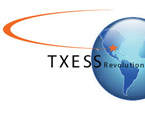
The state of Texas is in the midst of a major overhaul of high school science education. To graduate on the preferred or distinguished track, students will soon be required to complete four years of science. When the new guidelines were approved in 2006, only two other states, Alabama and Idaho, required four years of science.
Texas will also bring back earth science (after cutting it in the 1990s) as one of several options to fulfill the required fourth year. The new course, Earth and Space Science (ESS) will be taught as a “capstone course,” integrating material from a range of disciplines to help students make connections across subjects.
The changes could help catapult Texas to the vanguard of science education in the nation. But with the first high school seniors starting their required fourth year of science in just two years, where are the teachers for ESS going to come from?
| Minority Degrees
Minority students who stay on for graduate dregrees opt les and less for science and engineering (S&E) degrees. In 2004, 31.5 percent of minority students with bachelor’s degrees were in S&E fields. That year, just 17 percent received master’s, and only 4 percent received doctorates in S&E fields.
|
The state of Texas already struggles with a chronic shortage of science teachers. In 2008/09, the Texas Education Agency (TEA) designated science as one of six “subject-matter teacher shortage areas,” making teachers who are willing to teach science eligible for special benefits. Another indicator is the proportion of teachers who are not certified in the subjects they teach. According to the Council of Chief State School Officers, in 2006, 24 percent of high school chemistry classes in Texas were taught by non-certified teachers. The proportion is higher for other sciences (28 percent for biology and 46 percent for physics).
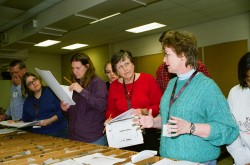
Scientists and education experts at the University of Texas at Austin’s Jackson School of Geosciences were instrumental in convincing the state to change the science requirements and options. Now they’re working to boost the state’s capacity to teach the new course through the TeXas Earth and Space Science Revolution (TXESS Revolution), a five-year, $2.38 million initiative to train eighth through twelfth grade teachers in earth science.
“Teacher preparation for the new capstone course is essential to help ensure that the course remains a viable option for core credit to satisfy the fourth year of science in Texas,” said Kathy Ellins, TXESS Revolution lead principal investigator.
Talking About a Revolution
During the five-year program, two cohorts of about 70 teachers each attend a series of professional development academies (PDAs) and two-week summer institutes. In the trainings that began earlier this year, they learn innovative techniques such as inquiry based learning and develop classroom activities based on real data and research stories from scientists.
Like ripples in a pond, they then train colleagues in their own regions. Those teachers in turn use the unique teaching methods and activities with their own students. Through this multiplier effect, the 140 participants will eventually impact hundreds of other educators and thousands of students.
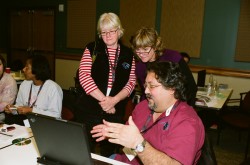
For the teachers, it’s a chance to be a student again.
“We know very well from studies that if you want teachers to use a curriculum, they need to go through it themselves,” said Karen Ostlund, chair of the TXESS Revolution Advisory Board. “If you give them a kit with materials and a teacher’s guide, it’s not as likely that they will use it unless the teacher is really gung ho.”
Instead, researchers from the Jackson School share their research stories and data with the teachers who then use that information to step inside the scientists’ shoes and try to solve a problem. So in a sense, they are teachers experiencing what it’s like to be students experiencing what it’s like to be scientists.
“It’s not too often that teachers can get real data and talk with people who collected it,” said Hilary Olson, Institute for Geophysics researcher and co-principal investigator for the program. “They go from not knowing about a topic to several hours later, they feel pretty confident with their answers.”
The TXESS Revolution project is designed to inspire teachers so that they can in turn inspire their students.
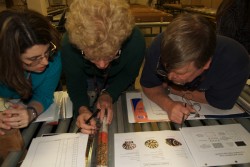
“Research shows that unless kids are exposed to a career, they will never think of going into it,” said Ostlund. “Perhaps some kids have never thought of being a scientist, but this would show them this could be an exciting life.”
In other words, the program isn’t just about filling a need for outstanding science teachers in the next two or three years, it’s about stoking the cycle of excitement around science and science teaching as vocations.
“If we don’t have the teachers who are energetic and who love the content and are exemplary, then the kids aren’t going to be interested enough to go to college to study science and become a science teacher,” said Ostlund. “It’s a cycle. At some point, you have to get someone that turns you on to science. That’s obviously what teachers who go through TXESS Revolution are meant to do.”
Another thing that sets TXESS Revolution apart from other teacher training programs is its emphasis on inquiry based learning in which students generate their own questions, make a prediction or form a hypothesis that they can test, set up an investigation and create a process that they can follow to answer the questions. They collect data, look for patterns and draw conclusions. According to Ostlund, the inquiry based approach leads to deeper learning.
“Good inquiry leads to two questions where there was only one,” she said. “In the process, you learn thinking skills that you use to ask and answer questions. Teachers have to challenge the students with questions that cause them to connect the dots and find out what is going on.”
Cupcakes for Science
The professional development academies (PDAs) last two-and-a-half days and include training with geoscience data, field trips, guest lectures and other special programs. Each cohort of teachers participates in four PDAs. The first one, “Poking Holes Into the Planet,” held February 14-16, focused on how geologic cores and geophysical logging can help scientists better understand Earth processes and improve the search for resources.
One of Meredith Keelan’s favorite exercises involved taking an earth science activity and modifying it for different grade levels. Keelan, a high school science teacher from Van Vleck, Texas, chose the drill core activity in which teachers examined clear plastic tubes filled with sand, gravel and other materials. These tubes simulate the core samples drilled out by geologists searching for oil and gas or trying to understand events in the geologic past such as flooding, volcanism and climate change.
Reading cores is an important, yet difficult skill for geologists. But how can a teacher convey a sense of this complicated process in the classroom without the real cores that scientists use, and make it interesting for students from fifth through twelfth grade?
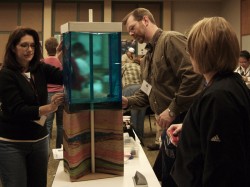
“I wrote an activity using cupcakes,” said Keelan. “I baked them with different layers of white and chocolate cake and layers with or without chocolate chips or nuts. The students stick hollow glass rods into the cupcakes and pull out cores. Then they can measure the thicknesses and types of layers.”
She plans to use the activity in the coming year in her high school classes. Her elementary school colleagues plan to use it too.
When she presented it to her fellow teachers in the second TXESS Revolution professional development academy, most liked it. But being teachers, they couldn’t resist grading it. During her demonstration, the rubber cork on the end of her glass rod popped off and the “core” began to ooze out. The teachers suggested not using the cork because it allowed pressure to build up in the rod. When one of the geologists leading the trainings commented that that sometimes happens at real drill sites with real cores, she felt vindicated.
“Teachers are hard to teach,” she said. “They are a tough audience.”
Virtually There
Teachers who participate in the TXESS Revolution program make a commitment to travel to Austin for trainings several times a year for two years. The rest of the time, they stay in touch through a “virtual café” on the TXESS Revolution website. They share classroom activities, science news, personal stories and teaching strategies. They can also share their feedback about how the program is going and what could be improved with independent evaluators from the University of Texas at Tyler.
The architect and manager of this online learning community is Eleanour Snow, a visiting scientist from the University of South Florida (USF) now at the Institute for Geophysics. Snow, who is the project’s co-principal investigator, has taught geology at the university level for 21 years. At USF, she was among the first of the faculty to take her teaching online, developing and teaching courses entirely on the Internet. She continues to teach over 1,000 students for USF each semester from Austin.
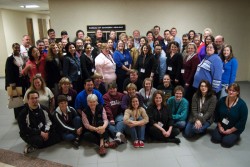
She noted that teachers come from across the state, learn a lot of material, make a lot of new friends and then go back to their own communities where they sometimes feel a little isolated.
“One of the challenges is to keep the conversation going and keep them interested and excited between our workshops,” said Snow. She hopes the online community has an even broader impact.
“I really want teachers to start using the Internet more,” she said. “Students are so much more computer savvy than they are. That’s how they communicate. So showing the teachers how to involve students in online learning is critical.”
“We’re setting a trend here in Texas,” said Ellins, who originally proposed the online community. “I don’t know of any other program in Texas that does this. It is a way to keep people engaged using social networking skills.”
In addition to the short PDAs, teachers also attend two two-week summer institutes. The first institute, held June 15-27, included “Earth Science By Design,” as well as a week-long Central Texas field program.
Earth Science by Design was developed by the American Geological Institute and TERC, a non profit organization dedicated to improving math, science and technology teaching, to help teachers teach to the big ideas in earth and space science and use visualizations and satellite imagery to promote student understanding.
The Central Texas field program was led by Jon Olson of the university’s Department of Petroleum and Geosystems Engineering and included field visits to geologic sites of interest in Central Texas, as well as instruction in various map-reading skills using geologic and topographic maps available online and integrating them with applications such as Google Earth.
The program, based at the University of Texas at Austin, received $1.48 million from the National Science Foundation’s Opportunities for Enhancing Diversity in the Geosciences program with matching grants from two divisions within the university: the Jackson School and the Texas Regional Collaboratives for Excellence in Science and Mathematics Teaching within the College of Education.
In addition to the Jackson School and the College of Education, major partners include the University of Texas at Austin’s Department of Petroleum and Geosystems Engineering, TERC, and the University of South Florida.
by Marc Airhart
For more information about the Jackson School contact J.B. Bird at jbird@jsg.utexas.edu, 512-232-9623.
